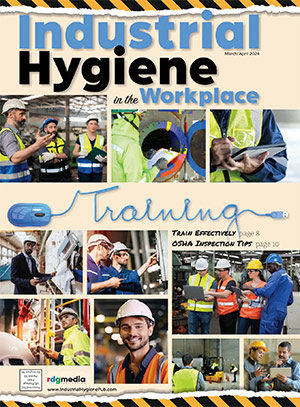Sensor Technology for Peace of Mind
By: Todd Hardwick, Contributor
Industrial settings provide ample opportunities to put a worker’s health and safety at risk. In 2021, the most recent data available, there were 5,190 fatal work injuries in the U.S., according to the U.S. Bureau of Labor Statistics.
Equipment, policies and procedures need to come together to ensure an overall safe environment for workers. A safe workplace can boost employee retention and the company’s reputation, while unsafe conditions can lead to legal and financial consequences for companies. It’s crucial workers have the tools necessary to ensure their safety and security on the job.
The Importance of Sensor Technology

PID sensors are small and discreet, so they can be used in equipment that can be worn for safety monitoring while the worker is in a confined space. (photo courtesy AMETEK MOCON)
Sensor technology is a first line of defense for workers, giving them peace of mind when they’re at risk from dangerous levels of volatile organic compounds (VOCs). The accuracy of that technology is critical. Even at low concentration levels, VOCs such as benzene pose a threat to workers in environments like petrochemical refineries, where workers can be exposed to VOCs through routine sampling and maintenance operations, surface spills and pipeline leaks.
Concentrations of VOCs can be up to 10 times higher indoors than outdoors, according to the U.S. Environmental Protection Agency. VOCs can quickly become deadly, but the primary concern is the negative health effects of long-term exposure to VOCs. Health effects can include damage to the liver, kidneys or central nervous system.
A Photoionization Detector (PID) is a commonly used gas detection technique in industrial hygiene instruments to measure a wide variety of organic compounds and some inorganic gases in ambient air. When the gas level or VOC level becomes too high, an alarm in the instrument goes off to tell the person to leave the space.
“These sensors are used in industrial hygiene applications, like confined space monitors that are worn on your belt or lapel. This technology can save your life,” said AMETEK MOCON Global Product Manager Todd Hardwick.
Convenient, Reliable Technology

A Photoionization Detector (PID) is a commonly used gas detection technique in industrial hygiene instruments to measure a wide variety of organic compounds and some inorganic gases in ambient air. (photo courtesy AMETEK MOCON)
Workers need an instrument that includes a sensor providing accurate, immediate results they can trust to protect their health and safety.
“Companies are responsible for ensuring their workers have the technology in place to safely complete their daily tasks. Having a trusted partner provide high-quality safety equipment, utilizing accurate sensors, can give them peace of mind that their workers are supported,” Hardwick stated.
Equipment that contains sensors is subject to a number of certifications, and having a partner that’s knowledgeable in those certifications—while creating a unique solution to meet the company’s needs—is key. Companies also need a partner who has a reliable supply chain, so they can quickly access new sensors when needed.
PID sensors are small and discreet, so they can be used in equipment that can be worn for safety monitoring while the worker is in a confined space, such as a mine or a tank in a refinery. They can weigh as little as 8g–ideal for workers who are at times carrying equipment into confined spaces. Although they’re small, these sensors commonly have detection limits of less than 1ppm to upwards of 2,000ppm. Sensors and equipment that contain them function for hours at a time every day, and workers can count on them for daily protection.
Industrial sites can also present a range of difficult temperatures and humid environments for workers, and quality sensors provide accurate measurements within that temperature and humidity range. Workers need a sensor that can continue to function accurately and reliably in high humidity, alerting a user if hazardous levels of VOCs are detected.
If something goes wrong at an industrial workplace, companies need to have the safety pieces in place to quickly address it. By equipping their workers with reliable sensor technology, they’re taking steps to be prepared and potentially save workers’ lives.
Todd Hardwick is a Global Product Manager at AMETEK MOCON. He has been in the sensors and instrumentations industry for more than 30 years.
Share on Socials!
Monitoring Workers’ Exposure in Confined Spaces
How Has COVID-19 Affected Environmental Compliance?
Air Quality Instrumentation: A History
Leaders in Industrial Hygiene
Council for Accreditation in Occupational Hearing Conservation (CAOHC)
Subscribe!
Sign up to receive our industry publications for FREE!










